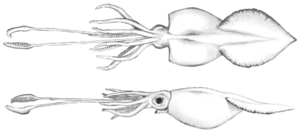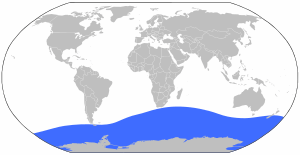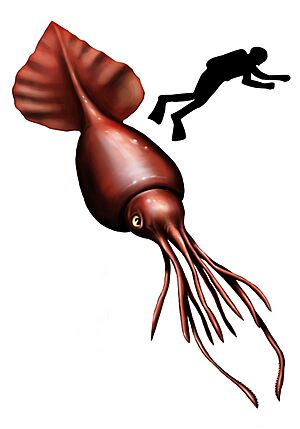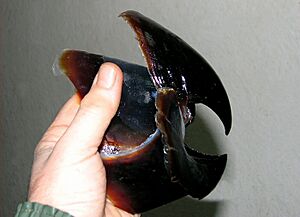Colossal squid facts for kids
Quick facts for kids Colossal squid |
|
|---|---|
 |
|
| Depiction with an inflated mantle | |
| Conservation status | |
| Scientific classification | |
| Genus: |
Mesonychoteuthis
|
| Species: |
hamiltoni
|
 |
|
| Global range of M. hamiltoni | |
The colossal squid (its scientific name is Mesonychoteuthis hamiltoni) is the biggest squid by weight. It is also the largest known animal without a backbone, called an invertebrate. These amazing creatures can weigh from 495 kilograms (1,091 lb) up to 700 kilograms (1,500 lb)!
They can grow to be about 10 metres (33 ft) to 14 metres (46 ft) long. Scientists first found and described them in 1925.
Contents
Discovering the Colossal Squid
The colossal squid, known scientifically as Mesonychoteuthis hamiltoni, was first discovered in 1925. Scientists found two arm crowns from this squid inside the stomach of a sperm whale. It was named Mesonychoteuthis hamiltoni after E. Hamilton, who made the first discovery. This species belongs to a group of animals called Cephalopoda and is part of the Cranchiidae family. The scientist Guy Coburn Robson officially described it.
What Does a Colossal Squid Look Like?
The colossal squid has one pair of gills, a hard beak (like a bird's beak), eight arms, and two long tentacles. It also has a head and two fins. Like other squids, it uses a part of its body called a mantle to move around in the water.
What makes the colossal squid special is that it is the only squid in its family (Cranchiidae) that has hooks on its arms and tentacles. These hooks can either swivel or have three points. Other squid families might have hooks, but no other squid in the Cranchiidae family does.
Where Do Colossal Squids Live?
The colossal squid lives mainly in the Southern Ocean. Its known home stretches thousands of kilometers north from Antarctica. You can find them near southern South America, southern South Africa, and the southern tip of New Zealand.
Colossal squids are often seen near the Cooperation Sea. They are seen less often near the Ross Sea. This is because of where their food lives and where their competitors, like the Antarctic toothfish, are found.
How Do Colossal Squids Behave?
Scientists do not know much about how colossal squids behave. However, they believe these squids eat prey like small worms called chaetognatha. They also eat large fish such as the Patagonian toothfish and smaller squids.
A big part of the colossal squid's diet is the Antarctic toothfish. Because of its large size, the colossal squid likely hunts big fish and smaller squids. Its main predators are sperm whales and sleeper sharks.
Who Hunts the Colossal Squid?
Colossal squids are a very important food source for sperm whales in the Antarctic. Many other animals also eat colossal squids. These include beaked whales, such as southern bottlenose whales, Cuvier's, and Baird's beaked whales.
Other animals that might hunt colossal squids include the pilot whale and killer whales. Large southern elephant seals, Patagonian toothfish, southern sleeper sharks (Somniosus antarcticus), and Antarctic toothfish also prey on them. Even large seabirds like albatrosses (for example, the wandering and sooty albatrosses) might eat them.
How Do Colossal Squids Reproduce?
Scientists do not know much about how colossal squids reproduce. We do know that there are male and female squids. Young squids are thought to lay their eggs near the surface during the summer. The water temperature at this time is around −0.9–0 °C (30.4–32.0 °F).
Is the Colossal Squid Endangered?
The colossal squid is listed as "least concern" on the IUCN Red List. This means it is not currently at high risk of disappearing. Fishermen do not usually try to catch colossal squids. They are only caught by accident when they try to eat fish caught on hooks. Also, because they live in very deep waters, it is rare for humans to interact with colossal squids.
Amazing Facts About the Colossal Squid

- The colossal squid has the largest eyes of any known creature. Their eyes are estimated to be about 27–30 cm (11–12 in) to 40 cm (16 in) wide.
- Their eyes can also glow in the dark! This is because they have special parts called photophores. These contain tiny living things called symbiotic bacteria that make light through a chemical reaction.
- It is thought that the colossal squid's eyes can spot predators moving from over 120 meters away.
- The colossal squid has a very slow metabolic rate. This means it does not need much food to live. An adult weighing 500 kilograms (1,100 lb) only needs about 30 grams (1 oz) of prey each day.
- Colossal squids are mostly deaf to high-pitched sounds, like whale sonar. So, they mostly rely on seeing things to avoid being eaten.
- The biggest colossal squid ever recorded was caught in February 2007. It weighed 495 kilograms (1,091 lb).
Images for kids
-
The specimen on display at the Museum of New Zealand Te Papa Tongarewa
-
Colossal squid on display in the Te Papa museum in Wellington
-
Colossal squid head and limbs, Natural History Museum, London
See also
 In Spanish: Calamar colosal para niños
In Spanish: Calamar colosal para niños






